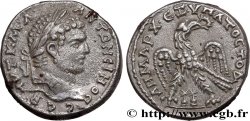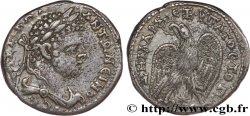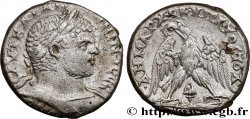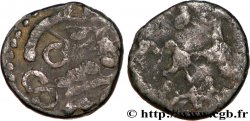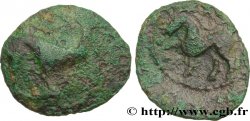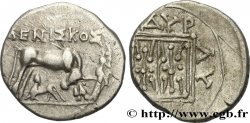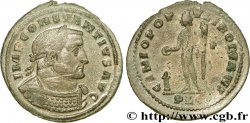bpv_173770 - CARACALLA Tétradrachme syro-phénicien
недоступный.
Товар уже продан в нашем интернет-магазине
Цена: : 580.00 €
Товар уже продан в нашем интернет-магазине
Цена: : 580.00 €
Тип Tétradrachme syro-phénicien
Дата: 215-217
Монетный двор / Город: Héliopolis, Syrie, Coelé Syrie
Металл: billon
Диаметр: 29 mm
Ориентация осей монеты: 12 h.
Вес: 13,57 g.
Редкость: R1
Комментарии о состоянии
Presque splendide, ne semble jamais avoir circulé mais a perdu son brillant de frappe au nettoyage. Flan exceptionnellement large
Ссылки в каталоге: :
Лицевая сторона
Аверс: описание: Tête laurée de Caracalla à droite, l’un des deux rubans de la couronne laurée descendant sur l’épaule (O*).
Аверс: легенда: AUT K. MA..ANTWNEINOS .SEB. (Autokrator Kaisar Markos Aurhlios Antwneinos Sebastos)
Аверс: перевод: (L’empereur césar Marc Aurèle Antonin auguste).
Обратная сторона
Реверс: Описание: Aigle debout à gauche, les ailes déployées, la tête et la queue tournées à droite, couronne feuillée dans le bec ; entre les pattes de l’aigle, un lion passant à droite sous une étoile à six rais et entre deux points.
Реверс: легенда: DHMARC. EX. UPATOS TOD. (Dhmarcikhs Exousias Upato to D)
Реверс: перевод: (Puissance tribunitienne, consul pour la quatrième fois).
Комментарий
Ce type se caractérise par un omega majuscule dans la légende de droit.
L’atelier d’Héliopolis Baalbeck doit la confirmation définitive de son attribution à la découverte par le Père Mouterde d’un autel dans la cour du grand temple de Baalbeck portant l’inscription IOMH REGVLO : Iovi Optimo Maximo Heliopolitano REGVLO (Jupiter le meilleur, le plus grand, héliopolitain, de Regulus). La représentation entre les pattes de l’aigle est une représentation astrologique, celle de l’étoile Régulus dans la constellation du lion, symbole de royauté. On peut rajouter un petit détail, qui n’est pas relevé dans le Prieur, à savoir que les deux points qui, sur plusieurs coins, semblent marquer le début et la fin de la légende de revers ne sont pas des points de ponctuation, ce sont des planètes qui entourent Régulus et le Lion, très probablement Venus et Mercure, qui, avec l’aigle-Jupiter, reconstituent la triade héliopolitaine.
On note que les sigma sont gravés en C.
Dans la base TSP maintenue par Michel Prieur, seize exemplaires sont maintenant répertoriés. Notre exemplaire, qui provient de la trouvaille dite de van Hoof, Jahrbuch für Numismatik und Geldgeschichte, Band XXXVI, 1986, pp. 107/126, plates 15/17, Christine Van Hoof N° 120 , est le 1193_004.
This type is characterized by a capital omega in the right legend.
The Heliopolis Baalbeck workshop owes its definitive confirmation of its attribution to the discovery by Father Mouterde of an altar in the courtyard of the great temple of Baalbeck bearing the inscription IOMH REGVLO: Iovi Optimo Maximo Heliopolitano REGVLO (Jupiter the best, the greatest, Heliopolitan, of Regulus). The representation between the eagle's legs is an astrological representation, that of the star Regulus in the constellation of Leo, symbol of royalty. We can add a small detail, which is not noted in the Prior, namely that the two points which, on several corners, seem to mark the beginning and the end of the reverse legend are not punctuation points, they are planets which surround Regulus and Leo, very probably Venus and Mercury, which, with the eagle-Jupiter, reconstitute the Heliopolitan triad.
Note that the sigmas are engraved in C.
In the TSP database maintained by Michel Prieur, sixteen examples are now listed. Our example, which comes from the so-called van Hoof find, Jahrbuch für Numismatik und Geldgeschichte, Band XXXVI, 1986, pp. 107/126, plates 15/17, Christine Van Hoof No. 120, is 1193_004
L’atelier d’Héliopolis Baalbeck doit la confirmation définitive de son attribution à la découverte par le Père Mouterde d’un autel dans la cour du grand temple de Baalbeck portant l’inscription IOMH REGVLO : Iovi Optimo Maximo Heliopolitano REGVLO (Jupiter le meilleur, le plus grand, héliopolitain, de Regulus). La représentation entre les pattes de l’aigle est une représentation astrologique, celle de l’étoile Régulus dans la constellation du lion, symbole de royauté. On peut rajouter un petit détail, qui n’est pas relevé dans le Prieur, à savoir que les deux points qui, sur plusieurs coins, semblent marquer le début et la fin de la légende de revers ne sont pas des points de ponctuation, ce sont des planètes qui entourent Régulus et le Lion, très probablement Venus et Mercure, qui, avec l’aigle-Jupiter, reconstituent la triade héliopolitaine.
On note que les sigma sont gravés en C.
Dans la base TSP maintenue par Michel Prieur, seize exemplaires sont maintenant répertoriés. Notre exemplaire, qui provient de la trouvaille dite de van Hoof, Jahrbuch für Numismatik und Geldgeschichte, Band XXXVI, 1986, pp. 107/126, plates 15/17, Christine Van Hoof N° 120 , est le 1193_004.
This type is characterized by a capital omega in the right legend.
The Heliopolis Baalbeck workshop owes its definitive confirmation of its attribution to the discovery by Father Mouterde of an altar in the courtyard of the great temple of Baalbeck bearing the inscription IOMH REGVLO: Iovi Optimo Maximo Heliopolitano REGVLO (Jupiter the best, the greatest, Heliopolitan, of Regulus). The representation between the eagle's legs is an astrological representation, that of the star Regulus in the constellation of Leo, symbol of royalty. We can add a small detail, which is not noted in the Prior, namely that the two points which, on several corners, seem to mark the beginning and the end of the reverse legend are not punctuation points, they are planets which surround Regulus and Leo, very probably Venus and Mercury, which, with the eagle-Jupiter, reconstitute the Heliopolitan triad.
Note that the sigmas are engraved in C.
In the TSP database maintained by Michel Prieur, sixteen examples are now listed. Our example, which comes from the so-called van Hoof find, Jahrbuch für Numismatik und Geldgeschichte, Band XXXVI, 1986, pp. 107/126, plates 15/17, Christine Van Hoof No. 120, is 1193_004








 Cообщить об ошибке
Cообщить об ошибке Распечатать страницу
Распечатать страницу Отправить мой выбор
Отправить мой выбор Задать вопрос
Задать вопрос Consign / sell
Consign / sell
 Информация
Информация